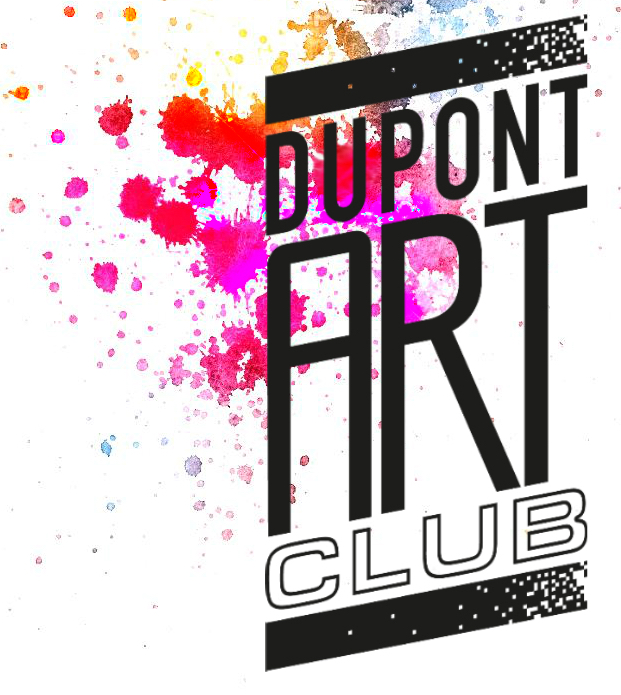News and Articles
Read about upcoming exhibitions and see art demonstrations and art tutorials from Dupont Art Club.
Ripples and Reflections with Coloured Pencils

Caroline often starts in the middle of the picture and works out. The dark/light contrast attracted her so that was where she started drawing the buildings, measuring shapes in comparison with others. She drew with a 4B pencil but normally would choose a 7B. She hold the pencil from the end( the back) to get more movement. The shadows were drawn in blacks and grays in cross hatching to darken. Caroline said that the best pencils were polychrome and Albert Durer. The cheaper ones had lighter pigment. She recommended putting on the colour in a similar way to when using pastels. One can purchase the blender and burnished pencils to assist. With the colours, she blended colour to achieve the correct tone. With the yellow, she swirls green lightly over top to blend. Her black was not deep enough so she added dark green and red blending in. Also red and blue were used in another area. One can see hints of colour underneath. It is imprtant to make the marks in the direction of the ripples using swirls for the bushes. You can only add so much colour before the area is saturated. photos
Expressive Trees in. Watercolour
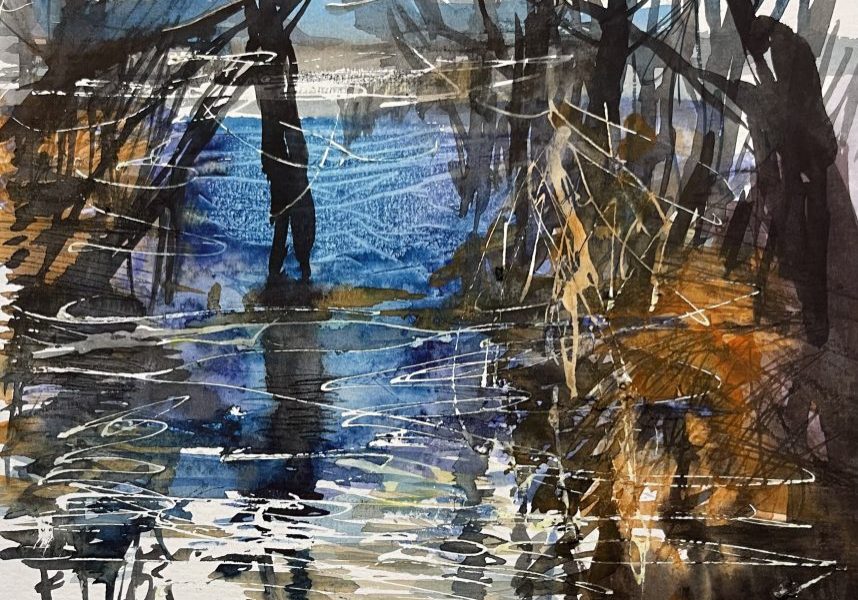
This workshop with Caroline started with the painting of white masking fluid over white areas and reflections.After letting it dry, she mixed pools of turquoise,purple, blue and orange. Painting the purple loosely she covered it with plastic wrap and left to dry. She removed this leaving a lovely texture. She added orange with deep brown for the trunk of the tree scratching into it. She added splatter and painting in the reflections scratching this side ways. She went on to paint the bushes and trees with the strong colours coming forward blending them into the water. She bent the reflections as they enter the water. Once it dried she removed the masking fluid and added small twigs and detail with a small brush.
Dupont Portrait Workshop
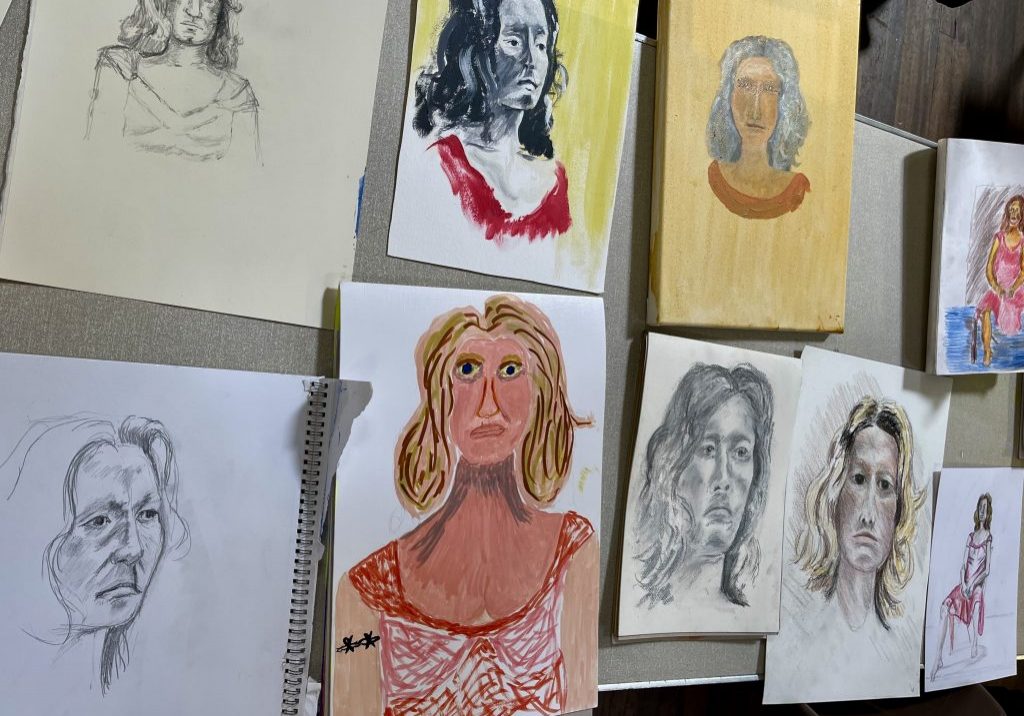
Caroline lead a workshop with sixteen eager members on how to draw a portrait from a live model. She started the afternoon with the basics on portrait drawing and left us to use what ever media we chose to do a head or full body painting/sketch. It was lots of fun with much hilarity over some of the results. Caroline was pleased with the results and we will be doing this again in the near future.
Oil Pastels with Flowers
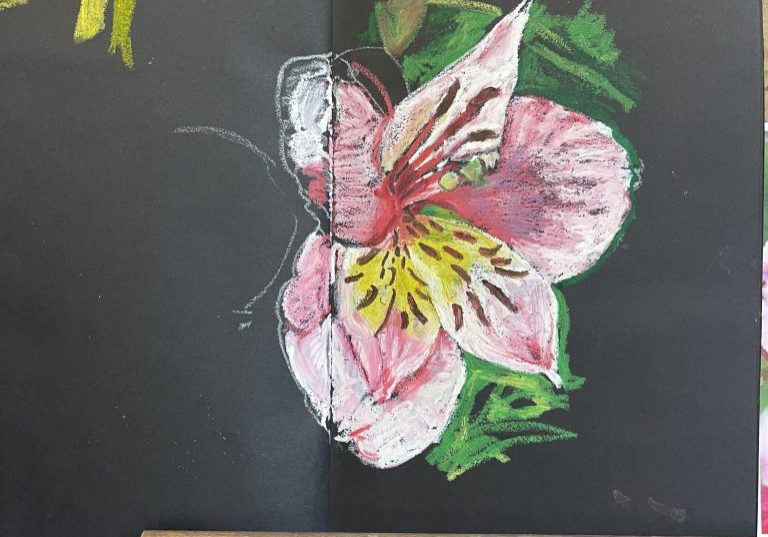
Caroline started off the demo showing us the two types of oil pastels that she was using. The first was Fabrer Castell which she used to draw in the shape of the flower in white pastel on a black background. These pastels are cheaper to buy and don’t fill in the colour effectively.. The second was Sennelier. These oil pastels are very soft and buttery with high pigment which covers the surface very well.. She often uses SeaWhite brown papers for her pastels. After drawing the shape of the flower she filled in from the outside towards the center with white showing texture. Pink and red were added. She used her fingers to blend.adding yellow at the base.She uses pale blue as shadows.She used cool and warm greens veridian and emerald, in the background. She finishes with details drawn in using dark browns and reds. As oil pastels never dry completely, they need to be framed behind glass.
DUPONT ART CLUB ANNUAL EXHIBITION!

Come visit us at Ventnor Hall at Blatchington Road in Hove (BN33YF) to see our annual ART EXHIBTION open daily from Thursday August 15th to Saturday August 17th 10AM - 5 PM There will be fabulous arts and crafts tables to visit as well.
Still life Drawing, shapes, colour , tone.
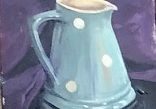
The still life painting started out with mapping out the shape. A line was drawn down the middle of the page after which the shape of the jug was drawen. Shadows and reflections were then painted in black with mixes of blue.Big brushes were used to add layers of shadow colors.Once the correct shape and position of the still life has been finalised, 3 shades of the main colour we’re mixed ready for the shadows and lights to be defined In light, medium and dark.remember red helps to dull colour down. An optical hit was given using another colour from a reflection. Orange works well with the. Blue. It is good to squint as it helps pick out the light and dark Which need highlighting to bring out a 3D effect. Reflections in shadows helps place the object and add interest. It is good to blend the colours while the paint is wet on the canvas. Keep squinting adding dashes of white with a rigger brush and slightly blending the paint. The ‘shine’ will draw the eye to the key areas you want to emphasise. Don’t forget the back drop, reflections, shine as it all adds to the 3D effect, Keep looking ,sitting back and checking to make sure you pick out the key light and dark areas. finished painting of the jug.
Painting Spring Flowers in Acrylic on a Black Surface
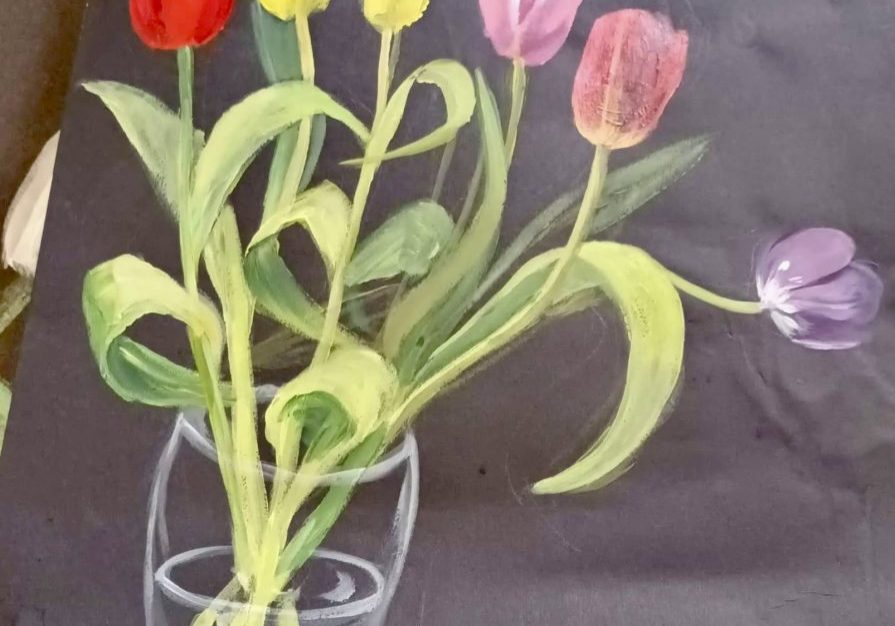
PAINTING SPRING FLOWERS IN ACRYLIC ON A BLACK SURFACE Lucy Parker demonstrated a dramatic version of a seasonal still life on good quality black paper. Many people were tempted to give it a try themselves during that afternoon, where Lucy was available to assist. She started by using quality acrylic paint with good pigment to ensure better coverage, otherwise there's a possibility that two coats will be needed. A brush loaded with paint and relatively little water is needed. Some transparent colours like yellows benefit from a white undercoat to ensure the black substrate does not show through. Lucy demonstrated a loose and expressive approach, not aiming for botanical accuracy, by building up a quick and sketchy base layer. She started painting the flowers from the base of the stems, moving quickly towards the head like a firework. Then the leaves were added to create a pleasing composition before working on painting the flower heads. When this layer dried she went back in to refine and add some details. During the demo we picked up many useful tips. Lucy reminded the audience of the benefits of a stay-wet palette to keep acrylic paint moist and workable longer. She shared tips on how to make one with a shallow tray containing damp kitchen paper and a layer of baking paper or tracing paper. Tips on mixing realistic shades of green, which were essential for this subject. And other useful colour mixing tips. Also colour loading with two different colours on the brush - so effective for the different colours in the tulips. Painting water with the elipse of the water line and the distortion of objects seen through water and clear glass.
Painting Spring Flowers In Acrylic on a Black Surface

PAINTING SPRING FLOWERS IN ACRYLIC ON A BLACK SURFACE Lucy Parker demonstrated a dramatic version of a seasonal still life on good quality black paper. Many people were tempted to give it a try themselves during that afternoon, where Lucy was available to assist. She started by using quality acrylic paint with good pigment to ensure better coverage, otherwise there's a possibility that two coats will be needed. A brush loaded with paint and relatively little water is needed. Some transparent colours like yellows benefit from a white undercoat to ensure the black substrate does not show through. Lucy demonstrated a loose and expressive approach, not aiming for botanical accuracy, by building up a quick and sketchy base layer. She started painting the flowers from the base of the stems, moving quickly towards the head like a firework. Then the leaves were added to create a pleasing composition before working on painting the flower heads. When this layer dried she went back in to refine and add some details. During the demo we picked up many useful tips. Lucy reminded the audience of the benefits of a stay-wet palette to keep acrylic paint moist and workable longer. She shared tips on how to make one with a shallow tray containing damp kitchen paper and a layer of baking paper or tracing paper. Tips on mixing realistic shades of green, which were essential for this subject. And other useful colour mixing tips. Also colour loading with two different colours on the brush - so effective for the different colours in the tulips. Painting water with the elipse of the water line and the distortion of objects seen through water and clear glass.
Nest and Eggs in Pastels
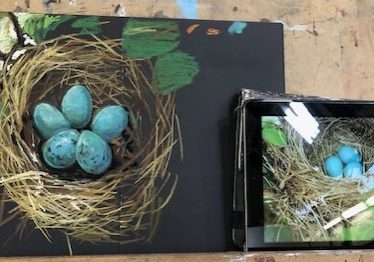
Birds nest and eggs Medium Chalk pastels on black paper. Work from dark to light, starting with a brown to outline the nest and position the eggs so they will form the focal point. Start building the nest with the dark browns introducing lighter colours and blending them, this can be done with the pastel stick or your finger. Make sure you decide on the direction of the light and add the lighter yellows and orange. It’s helpful to keep the colours you are using grouped together so you can keep going back adding and blending. Add the green leaves blending a little green reflections into the nest. Look for shapes of green and pick out details with yellow blending again. Use white to highlight the background creating a 3D effect. Build up the layers and gradually add the lighter, whites and yellows to add the details. Using black to define the shapes of the twigs. For the eggs, work dark to light again deciding where the light will fall. Dark blue blending in light blue, white for the light, all blended. Use black to define the shape of the eggs and add black in amongst the browns to give depth and contrast. Finally add the dark marks on the eggs following the shape, but not over working.
Planning a Painting
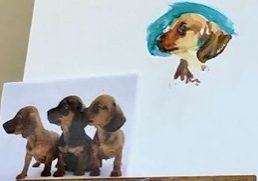
Caroline used a photo of 3 puppies, but the ideas were to be used on location so you can capture the tones and light of the moment. First she planned the construction of the painting using artistic licence to alter the height of one of the puppies to help the definition and balance, this also helped with blending the tones. Consider the background, different coloured backgrounds can enhance the colours of the paint and also can be used to reflect in the subject of the painting. Green can bring out reds. Caroline started with an eye as the focal point then built up the light colours, orange and yellow, moving to dark area and blending the colours to give many different tones. Then using dark red and dark green to create the browns, remember the light areas on the nose and which way the light is falling, add in the shadows, make notes, enough information to paint the subject in a weeks time by just referring to these plans which could help with creating a more natural finish.
Painting a Short Haired Black Dog

Caroline did a rough sketch in acrylic paint of the Labrador, then mixed colours rather than using black. She looked for colours which were picked up in the sheen from the surroundings, green and red to give it depth. Make it stand out rather than a boring photo. Blocked in all the dark areas first, mix of blue, yellow, red, then the mid shades and finally the details of the lighter colours which you can over lay with acrylic. The older and bristlier and uneven the brush the better, follow lines of the fur, lots of flicking strokes. Paint needs to be quite fluid so quite a bit of water. Details afterwards with a rigger brush and she did use true black to outline the nose, and only a little yellow in the white.
Pointalism in Watercolour
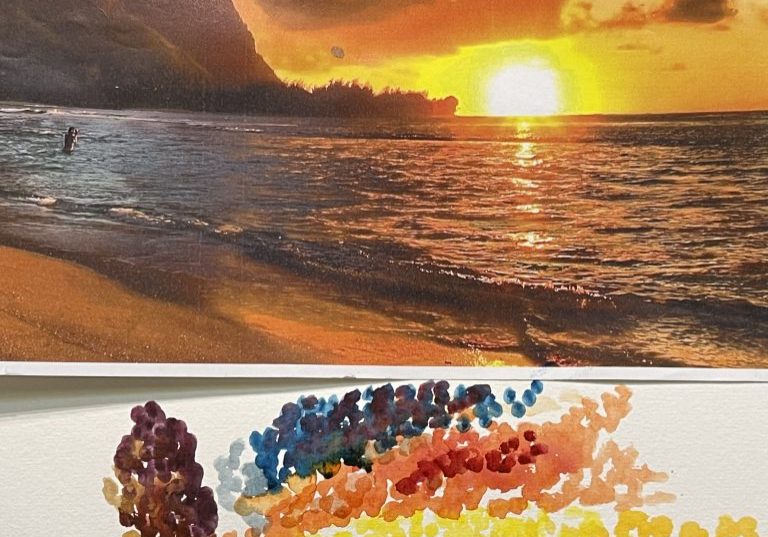
Pointillism describes a technique in which hundreds of small dots or dashes of pure colour are applied to the canvas in order to create maximum luminosity. Colour spots are blended into a range of tones. The dots of colour give a richer and more subtle effect then can be achieved by conventional techniques. George Seuart and Paul Signac were well known for using this technique. Check your colour wheel as using complimentary colours can intensify your colours. Caroline used cotton buds to add the dots to her painting blending with them. Viewing from a certain distance the dots of colour blend into a richer and more subtle effect.
Moody Landscapes with Acrylic
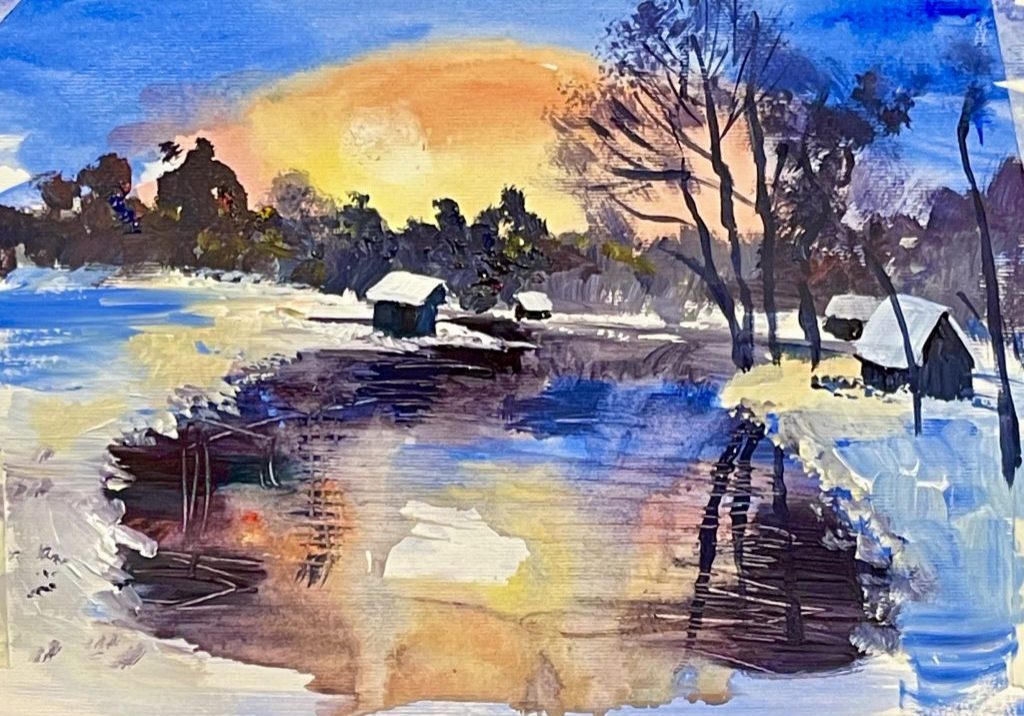
Caroline Marsland, Dupont instructor, started this painting using a fluid wash of acrylic with watercolour techniques, . Using these light washes gives luminosity to the sky which is painted with cobalt blue. You don’t get this affect with thick paint. Caroline added a yellow red mix with the blue on top for the sky, blending the colours. She then added the trees in pale grey over the luminous sky and darken the gray of the trees on the second layer trees to bring them forward. She dabbed down on her brush to add foliage. These sky reflections were painted in the pool and surrounding areas. She uses water to drip and blend these reflections. The snow was painted in white with a yellow and orange tinge in the water plus white with blue in other snowy areas, She tapped around the waters edge to give the snow texture. Trees were put in with a rigger, dragging the trunks shapes up, and the tops are added with tapping a brush to indicate foliage again. The small buildings are painted in with their snowy white roofs.
How to Draw Pastel in the Style of DEGAS
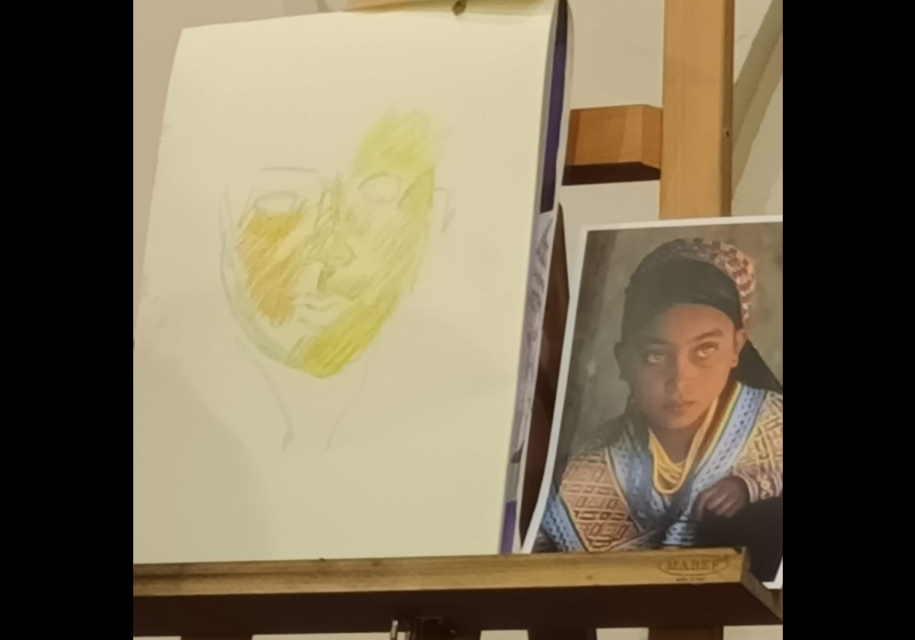
How to draw pastel portraits in the style of Degas Dupont Art Club instructor, Caroline Marsland used a reference photo of a young woman to demonstrate chalk pastel portrait using the linear layering technique used by Degas, who also influenced the work of Mary Cassatt. After a brief look at their paintings and an appreciation of the use of colour and mark making, we were shown how to apply hatched marks to give soft, lost edges and thus capture spontaneity and the moment. By building up layers of colour in the hatched marks, and often complementary colours side by side, the skin tones evolved from the lightest side through to the shadowed side of the face. None of the marks were blended but the optical effect produced lively and believable tones. The final stage is to use more detailed and finer marks for the features.
Using Warm and Cool Colours in your Landscape
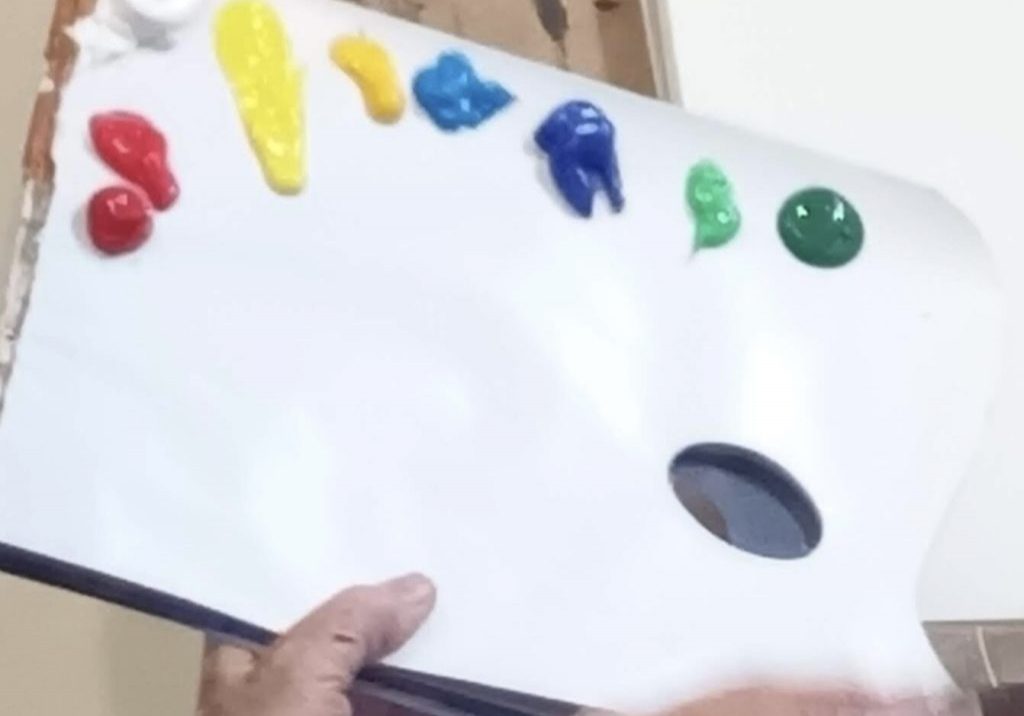
WARM AND COOL COLOURS. A landscape in acrylic Caroline showed how she sets up her palette with warm and cool versions of green, red, yellow and blue plus white. She painted a simple seascape to show how the principle of cooler and paler colours in the distance and darker, warmer colours in the foreground works to create the impression of depth and perspective. There are many examples of artists who adopt this way of working, particularly the Pre-Raphaelites. In this demo the sky is in the coolest tones of blue and uses cool, pale yellows for the sun. Mixing cool reds and cool blues results in lilac for the sunset sky. The sea in the distance is achieved with desaturated and cooler colours, and then coming forward uses increasingly warmer colour tones in the mixes. The immediate foreground rocks are painted in the warmest colours by mixing subtle warm-toned browns and chromatic black. By using pops of warm colour, the focal areas have been highlighted. Once completed, Caroline reviewed the whole picture and unified the background, midground and foreground by using touches of the same colours. Finally she adjusted the tonal values to ensure that the background recedes with palest tones and stronger colours in the foreground.
Colour Mixing for Dark Skin
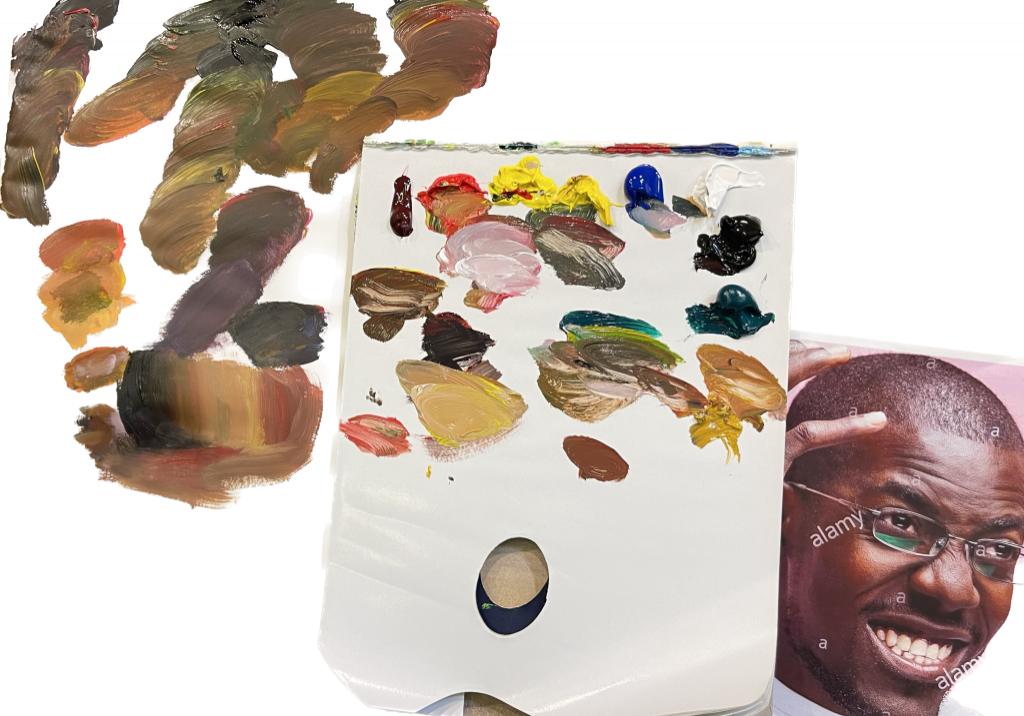
Dupont Art instructor Caroline gave a demonstration on mixing colors in order to obtain the right hue for dark skin. She stated that the actual color of the skin depends on the lighting in the room or the light outside. If looking at a photo, it also depends on the surrounding colors which reflect onto the skin. There are a number of ways of obtaining dark browns. Black, a cool, yellow and vermilion will give you a workable brown. You need remember the influence of warm and cool colors for mixing. Using yellow ocher gives a different brown to the skin tone. She stated that our other instructor Lucy, uses ultramarine blue and burnt sienna for excellent skin colors. The use 0f umber’s is common and mix with blue’s or reds or yellows can give you different browns. When mixing the scalp and hair as in the photo, she mixed a pale rose beige color followed by whisking darker colors onto it as seen in the photo below. The mixing is much easier with acrylics and oils. With watercolors, she never leaves the white exposed as white, but will lighten it with other light mixed colors before adding the above mixtures.
Painting with Ink and Bleach with a dash of Watercolor
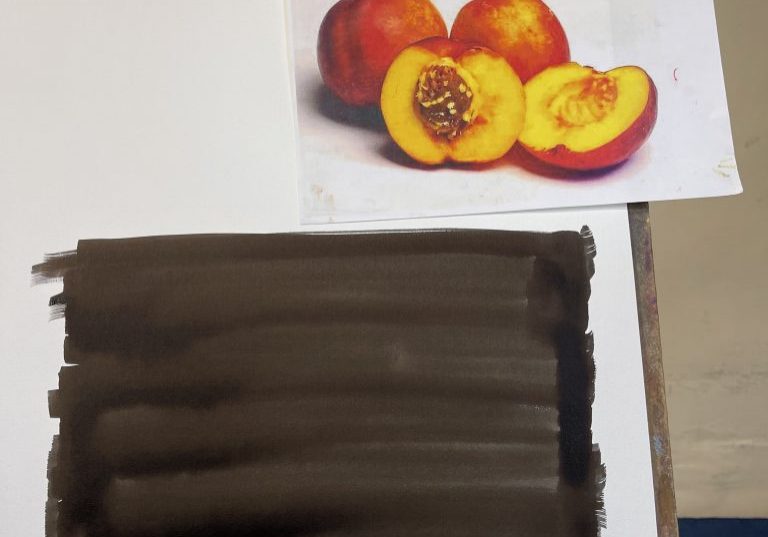
Ink and Bleach with a dash of Watercolour Supplies; thick bleach, Quink black Ink, brushes, watercolour paper, watercolours. Containers for water, thick bleach and weak bleach( half bleach half water). Indian Ink doesn’t shift as much as quink ink You must think about health and safety using bleach so use latex gloves, safety glasses if needed to protect your eyes, and a mask. Caroline started out with painting the watercolour paper with the quink ink and letting it dry. Using the weak bleach mixture she slowly drew the shapes of the peaches. Going light will come later. Not all the ink will be eventually be removed and will leave a lovely texture. Some inks will leave a brown or blue color when bleached. Lots of different brush strokes gave a lovely texture. Finally she used the strong bleach to really lighten the paper. She went back and forth to with the strong and weak bleach making lines on the table. Lastly she added thin layers of red and orange watercolour to the fruit and the shadows. In addition, you can add fine lines with a pen, and use water and wipe do Enjoy this process and play!
Painting Flowers with Watercolour
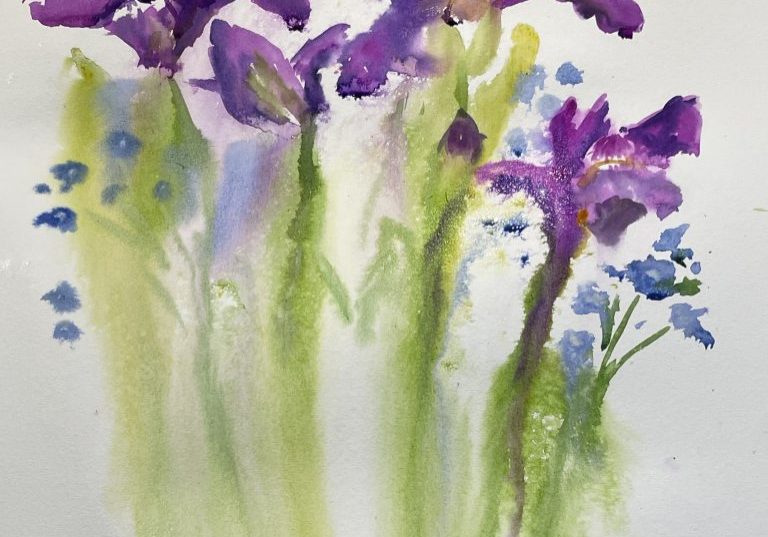
Caroline started her Irus flower by wetting the area that was to be painted. The base colour is put in and when it was somewhat dry, she added colour and shadows with the tip of her brush. Once dry she can add in more details. If she wants this to bleed a little, she will paint a line along the edge with clear water. For stems. she added in the darker areas and sprayed it to let it drip. The forget knots were added at the end.
Graphic Design: Designing for Fabric
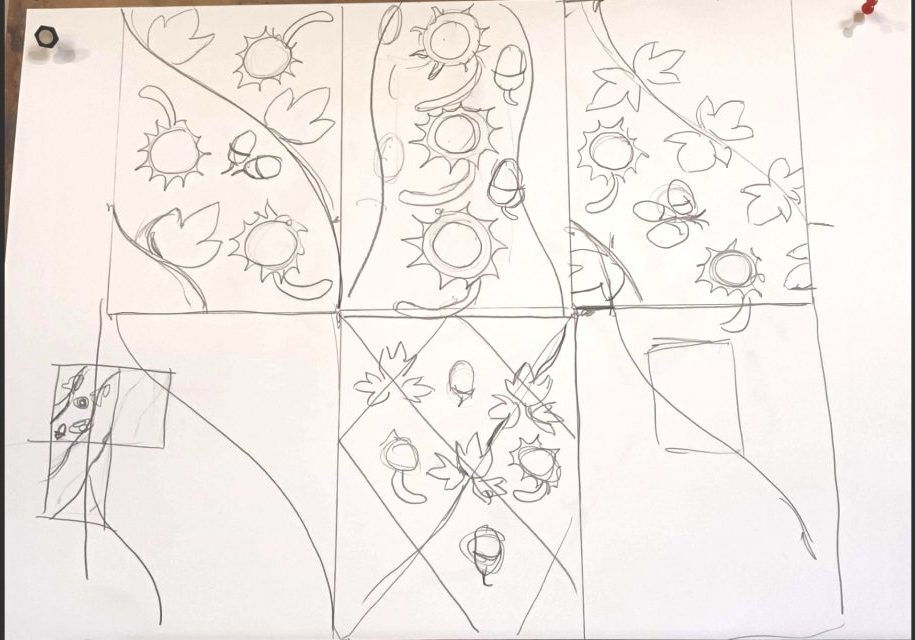
Graphic Design: Designing for Fabric. At our #dupontartclub Wednesday class, Caroline discussed the thought processes and construction of a design, and then demonstrated using graphic conkers, ivy and acorns imagery. The application for domestic fabric and wallpapers requires a repeatable design, various ideas of which were demonstrated and different example shown. The function of the designs requires thought as it will determine the style of image, the pattern, size and direction of the repetition, colour and tonal values amongst other considerations. Then the designer works on some ideas - producing thumbnail sketches and assessing them against these criteria - to then have the basis on which to work. In the discussion, Caroline showed various photos of existing graphic patterns, highlighting the popular styles of Laura Ashley and William Morris.
Capturing Texture in Driftwood using Watercolour
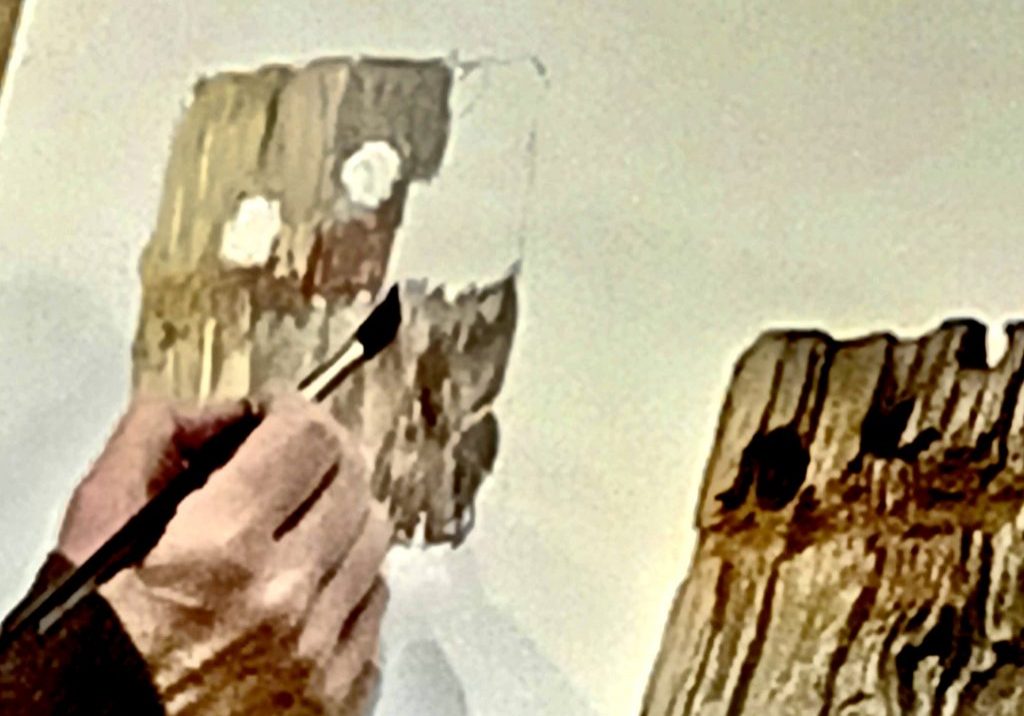
A demonstration on capturing texture in driftwood using watercolour Careful observation is key to the success of this still life. Dupont instructor, Caroline Marsland, laid down an underpainting of the lights and darks of the wood using the brush strokes vertically in the direction of the grain. Then using the tip of the brush to tap in lightly and wiggle to interpret the organic texture, marks and colours. Both wet in wet and wet onto dry techniques were used to allow the watercolour paint to move and blend softly, whilst following the direction of the grain as before. Some small patches were left unpainted at this stage. The next layer was painted when the underpainting was dry, to build up the texture and reinforcing the tonal values; mixing quite dark colours for the deep grooves and holes in the wood, and using a clean damp brush to lighten the palest areas. Surface texture was achieved by using the brush handle to lightly score the paper, which causes the paint to pool in the scratches. Finally, the holes and the side of the driftwood were worked on with more dark pigment to create a three dimensional quality. Any areas which had dried too light were also rectified. The demonstration was done using only one brush - a good quality squirrel hair number 12. This both holds plenty of paint, and retains a good pointed end for the smaller marks.
Painting like Cezanne
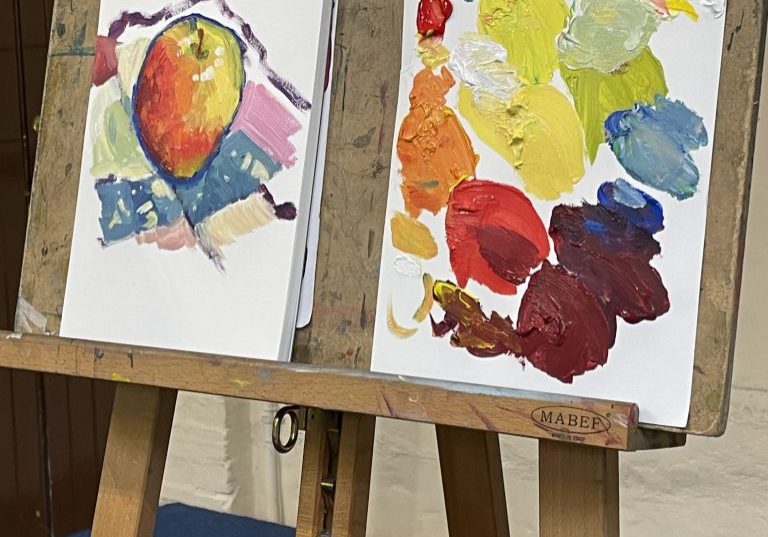
‘ Painting like Cezanne ‘Paul Cézanne was a French artist and Post-Impressionist painter whose work introduced new modes of representation and influenced avant garde artistic movements of the early 20th century’. Wikipedia Our instructor Caroline Marsland demonstrated and talked of the way Paul Cezanne painted. He looked for structure and forms in his paintings with the shapes and tonal values. He moved away from from browns and earth colours to working in saturated colours. He often would start with drawing the overall shape, often in a dark line and then laid each colour next to each one without blending. At times the paint was thick to add texture. With the highlights he would not use white as it looks flat so adding a little warm colour like pale yellow would warm it. More of Cézannes history is as follows. ‘While his early works are still influenced by Romanticism – such as the murals in the Jas de Bouffan country house – and Realism, Cézanne arrived at a new pictorial language through intensive examination of Impressionist forms of expression. He altered conventional approaches to perspective and broke established rules of academic art by emphasizing the underlying structure of objects in a composition and the formal qualities of art. Cézanne strived for a renewal of traditional design methods on the basis of the impressionistic colour space and colour modulation principles. Cézanne's often repetitive, exploratory brushstrokes are highly characteristic and clearly recognizable. He used planes of colour and small brushstrokes that build up to form complex fields. The paintings convey Cézanne's intense study of his subjects. Both Henri Matisse and Pablo Picasso are said to have remarked that Cézanne "is the father of us all". His painting provoked incomprehension and ridicule in contemporary art criticism. Until the late 1890s it was mainly fellow...
Drawing hands
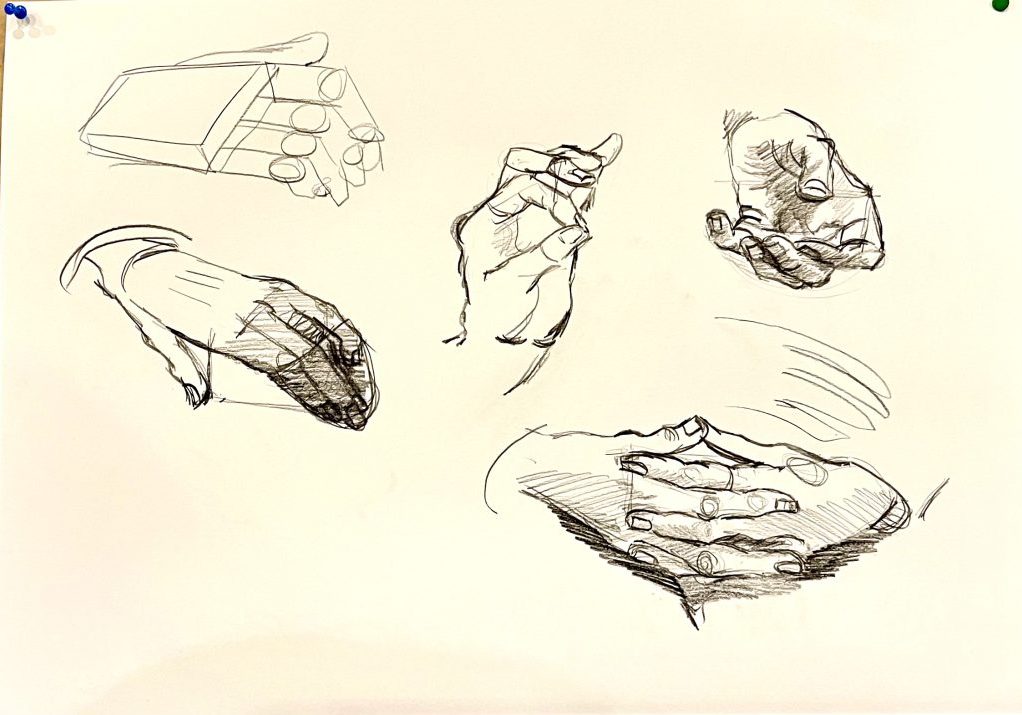
Caroline started the new year with a quick demonstration on drawing hands. Drawing hands start with drawing shapes composed of rectangles. . The palm is the largest rectangle . The fingers are made up of three rectangles built on each other. The end of the finger has a smaller pointed rectangle. The thumb is place on the side and it too is made up of three parts.. Move the finger shapes according to the model’s hand and make note of the knuckles which lay next to each other and are rounded.The tendons fan out from a central point to the fingers Depending on the shape of the hand, you will need to take into consideration of perspective which can shorten the shapes coming forward. Practice is very important in helping you to learn to draw hands accurately
Timed sketches
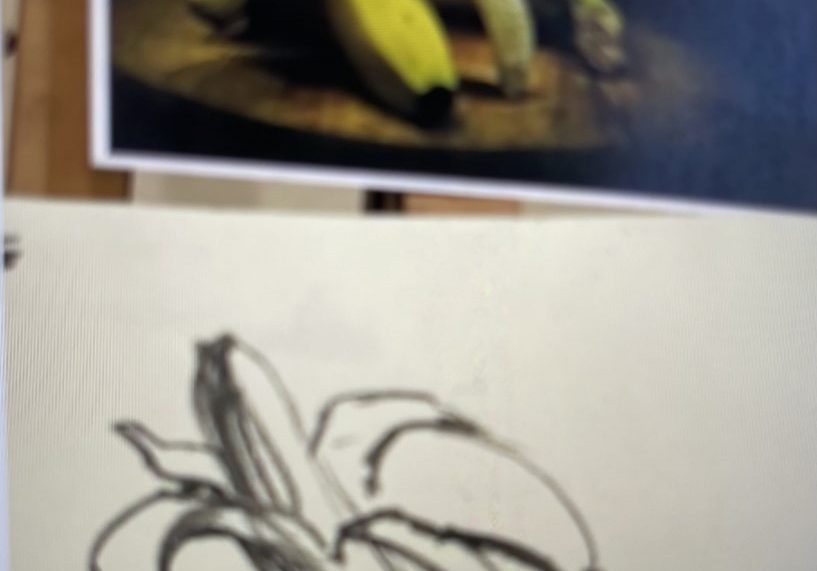
TIMED SKETCHES (1 minute/5 minutes/15 minutes). Caroline used charcoal and pastel paper. Pastel paper gets the best from charcoal as it has more ‘tooth’ giving stronger tonal values. Why timed sketches? The time limitation makes you really look. Concentrate on the line. Look at shapes, the major shapes, and corresponding shadows. Time restriction limits being tentative. Bold strokes. Do not look at trying to make a representational drawing, in the time allowed, rather to create an impression. Example One: The 1-minute drawing will be rougher but more expressive. Longer drawing times allows more detail. NB: Not seeking to create the ‘perfect’ image. Example 2 Cross hatch with charcoal and darken background areas – this can be very expressive. Draw a vertical line and then create shape (two halves) to represent vase. To bring the object forward ‘colour’ the background black – this will make object stand out. Example 3 The 5-minute drawing allows thought about details, for example shadows under the cream of the cakes. Study the light and dark – isolate the lighter areas. Charcoal allows blending with fingers or rubber. Look for tonal values. Initially get shapes down first and then shadowing. There is a balance with getting more details recorded but avoiding ‘fiddling’. Try to keep the drawing ‘loose’ - remember not seeking perfection. Example 4 The 10-15 minute – keep in mind this remains an exercise in observation. Extra time allows for more study particularly seeking out the horizontal and vertical shapes. Use a pencil to measure what is higher, lower and distances. Once shapes established start blocking in tonal values. Think of the picture as a jigsaw where each shape reveals the whole. Charcoal drawings can be used to emphasis the mood rather than a representation alone.
Sorry, we couldn't find any posts. Please try a different search.
